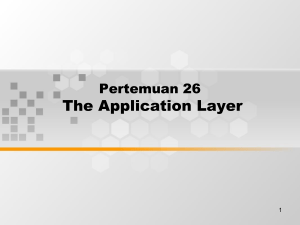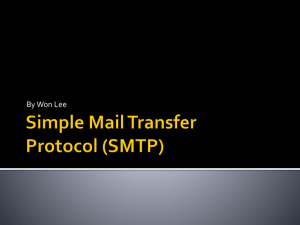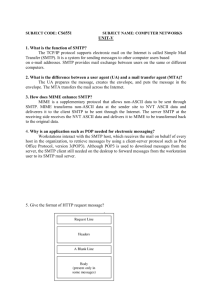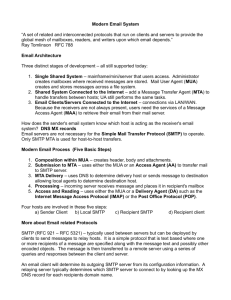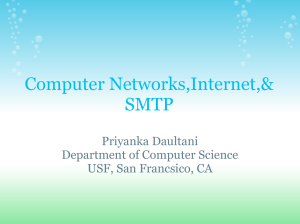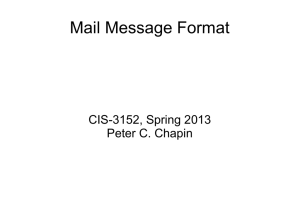Chapter 16: Distributed Applications Business Data Communications, 4e
advertisement
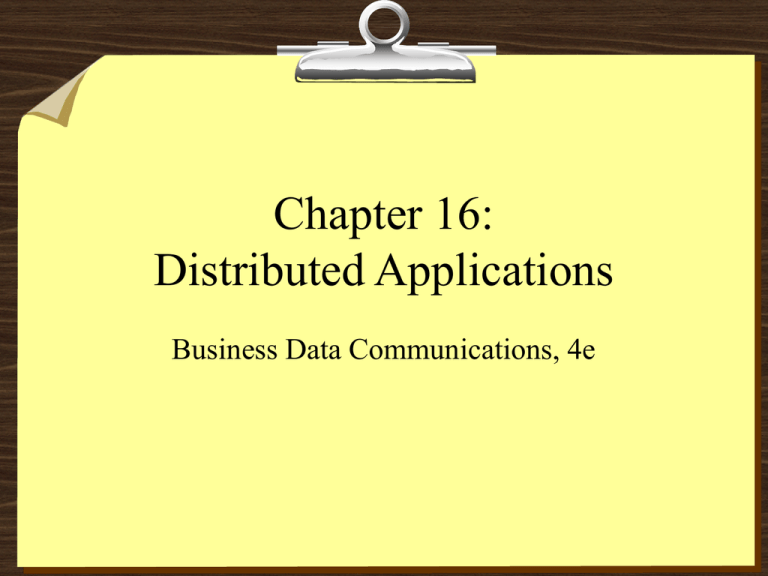
Chapter 16: Distributed Applications Business Data Communications, 4e Electronic Mail Features Message Preparation Word processing Annotation Message Sending User directory Timed delivery Multiple addressing Message priority Status information Interface to other facilities Message Receiving Mailbox scanning Message selection Message notification Message reply Message rerouting Business Data Communications, 4e 2 Single System E-Mail Only allows users of a shared system to exchange messages Each user has unique identifier and mailbox Sending a message simply puts it into recipients’ box e.g. RITVAX, AOL Business Data Communications, 4e 3 Multiple Systems E-Mail Distributed system enables mail servers to connect over a network to exchange mail Functions split User agent handles preparation, submission, reading, filing, etc Transfer agent receives mail from user, determines routing, communicates with remote systems Interconnection requires standards Business Data Communications, 4e 4 Simple Mail Transfer Protocol (SMTP) Standard for TCP/IP mail transfer, defined in RFC 821 Concerned addressing and delivery, not content, with two exceptions Character set standardized as 7-bit ASCII Adds log information to message that indicates message path Business Data Communications, 4e 5 Basic E-Mail Operation User creates message with user agent program Text includes RFC 822 header and body of message List of destinations derived from header Messages are queued and sent to SMTP sender program running on a host Business Data Communications, 4e 6 SMTP Mail Flow SMTP server transmits messages to appropriate hosts via TCP Multiple messages to same host can be sent on one connection Errors handling necessary for faulty addresses and unreachable hosts SMTP protocol attempts to provide error-free transmission, but does not provide end-to-end acknowledgement SMTP receiver accepts messages, places it in mailbox or forwards Business Data Communications, 4e 7 SMTP Connection Setup Sender opens TCP connection to receiver Receiver acknowledges connection with “220 Service Ready” or “421 Service Not Available” If connection is made, sender identifies itself with the “HELO” command Receiver accepts identification with “250 OK” Business Data Communications, 4e 8 SMTP Mail Transfer MAIL command identifies originator, provides reverse path for error reporting RCPT commands identify recipient(s) for message Receiver has several positive or negative responses to RCPT Sender will not send message until it is sure at least one copy can be delivered DATA command transfers message Business Data Communications, 4e 9 Sample SMTP Exchange S: MAILFROM:<Smith@Alpha.ARPA> R: 250 OK S: RCPT TO:<Jones@Beta.ARPA> R: 250 OK S: RCPT TO:<Green@Beta.ARPA> R: 550 No such user here S: DATA R: 354 Start mail input; end with <CRLF>.<CRLF> S: Blah blah blah…. S:…etc. etc. etc. S: <CRLF>.<CRLF> R: 250 OK Business Data Communications, 4e 10 SMTP Connection Closing Sender sends a QUIT command to initiate TCP close operation Receiver sends a reply to the QUIT command, then initiates its own close Business Data Communications, 4e 11 RFC 822 Defines format for text messages via electronic mail Used by SMTP as accepted mail format Specifies both envelope and contents Includes a variety of headers that can be included in the message header lines Business Data Communications, 4e 12 Limitations of SMTP and RFC822 Cannot transmit executables or binary files without conversion into text through non-standard programs (e.g. UUENCODE) Cannot transmit diacritical marks Transfers limited in size Gateways do not always map properly between EBCDIC and ASCII Cannot handle non-text data in X.400 messages Not all SMTP implementations adhere completely to RFC821 (tabs, truncation, etc) Business Data Communications, 4e 13 MIME (Multipurpose Internet Mail Extensions) Intended to resolve problems with SMTP and RFC822 Specifies five new header fields, providing info about body of message Defines multiple content formats Defines encodings to enable conversion of any type of content into transferable form Business Data Communications, 4e 14 MIME Header Fields MIME-Version: Indicates compliance with RFCs 1521 and 1522 Content-Type: Describes data in sufficient detail for receiver to pick method for representation Content-Transfer-Encoding: Indicates type of transformation used to represent content Content-ID: Used to uniquely identify MIME entities Content-Description: Plain text description for use when object is not readable Business Data Communications, 4e 15 MIME Content Types Seven major types: Text, Multipart, Message, Image, Video, Audio, Application Fourteen subtypes: See page 384 for details Text provides only plain subtype, but a richtext subtype is likely to be added Multipart indicates separate parts, such as text and an attachment MIME types are used by web servers, as well Business Data Communications, 4e 16 Electronic Data Interchange (EDI) Direct, computer-to-computer exchange of business data Replaces use of paper documents Requires two participants to agree on electronic format for the data Two departments within a company Companies and customers Multiple companies Business Data Communications, 4e 17 Benefits of EDI Cost savings Speed Reduction of errors Security Integration with office automation Just-in-time delivery Business Data Communications, 4e 18 EDI v E-Mail EDI E-Mail Typically no human involvement in processing the information; interface is software-to-software Data not necessarily structured for software processing. Human-tosoftware exchange is usually involved on at least one end Business Data Communications, 4e 19 Components of EDI Systems Application Translation Software Communications Network Business Data Communications, 4e 20 EDI/Internet Integration RFC 1767, issued in 1995 defines a method for packaging EDI transactions in a MIME envelope. Additional requirements have since emerged: Security issues such as EDI transaction integrity, privacy and non-repudiation Support for exchanges by point-to-point, FTP, and SMTP protocols. An IETF working group is currently addressing these unresolved Business issues. Data Communications, 4e 21 Enterprise Application Integration (EAI) linking applications, whether purchased or developed in-house, so they can better support a business process. Critical for implementation of Internet-based business strategies Business Data Communications, 4e 22 EAI Illustrated Business Data Communications, 4e 23
